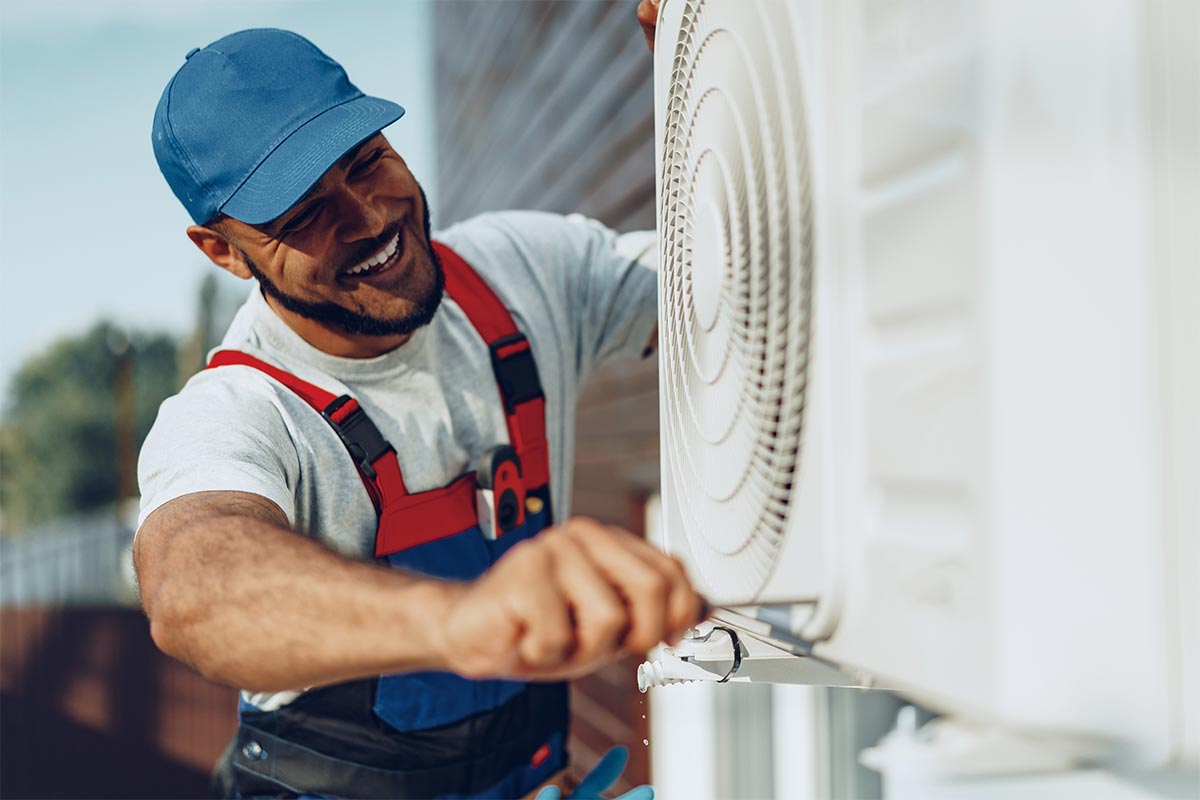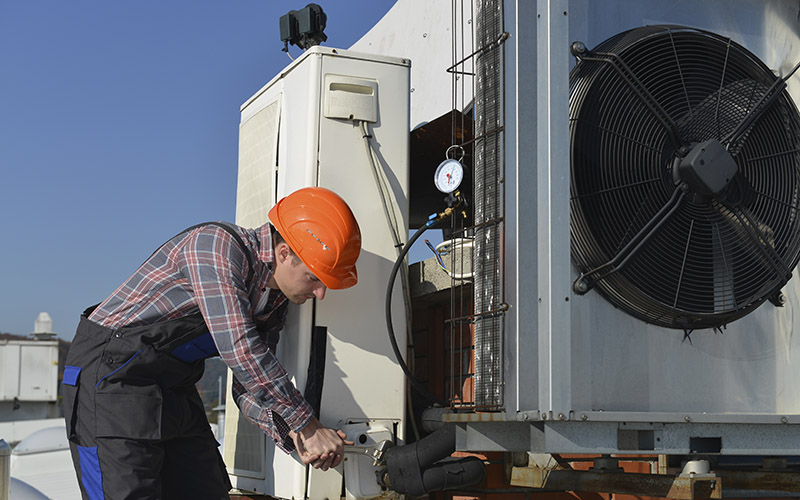The Top Benefits of Annual heat pump service
The Top Benefits of Annual heat pump service
Blog Article
Just How a Warm Pump and Heater Job With Each Other to Optimize Your Home's Home heating Performance
Recognizing just how a warm pump and heater interact is vital for house owners looking for reliable heating options. Each system has its staminas, supplying a well balanced technique to home convenience. The warmth pump masters modest temperature levels, while the heater supplies quick heat throughout severe cold. This synergy not only lowers power prices yet likewise enhances the life expectancy of both home appliances. What factors influence this collaboration, and how can homeowners optimize their advantages?
Recognizing Warmth Pumps: Exactly How They Work
Although lots of people might be unfamiliar with their inner operations, heatpump play a crucial duty in modern-day furnace. These devices run by moving heat from one area to one more, using the concepts of thermodynamics. In chillier months, a heatpump extracts warm from the outdoors air, ground, or water, and transfers it inside to heat the space. Alternatively, during warmer months, it can reverse the procedure, serving as an air conditioning system by expelling warmth from inside to the outside.Heat pumps include an evaporator, condenser, expansion, and compressor shutoff. The refrigerant within the system absorbs heat as it vaporizes at low temperatures and stress. The compressor then raises the pressure and temperature of the cooling agent, allowing it to release warm as it condenses. This efficient procedure can greatly minimize energy usage contrasted to typical heating techniques, making heat pumps a lasting choice for climate control in homes.
The Role of Heating Systems in Home Heating
Furnaces play a necessary duty in home heating by providing a dependable source of warmth throughout the cooler months. They run by creating heat via burning or electric resistance, dispersing it throughout the home using ducts or radiant systems. The effectiveness of a heating system is usually determined by its Annual Fuel Usage Effectiveness (AFUE) score, which suggests exactly how successfully the device transforms fuel into heat.Furnaces can use different energy resources, consisting of all-natural gas, power, gas, or oil, allowing house owners to pick the most suitable option for their needs. Unlike heat pumps, which might battle in severe cold, heaters maintain constant performance, making certain that interior temperatures continue to be comfortable no matter outdoor problems. Additionally, modern heaters typically come outfitted with sophisticated technology, such as clever thermostats and variable-speed blowers, boosting their effectiveness and responsiveness. This versatility makes heating systems a critical element in comprehensive home heating techniques.

Advantages of Utilizing Both Systems With Each Other
Integrating the staminas of both heaters and heatpump can result in a more reliable and effective home heating service. Making use of both systems allows home owners to take advantage of the heatpump's energy effectiveness throughout milder temperature levels while counting on the furnace for even more severe cold conditions. This twin strategy can considerably reduce energy costs, as heatpump consume less power than standard home heating methods when temperatures are moderate.Additionally, using both systems with each other can boost convenience levels in the home. Heatpump can supply regular, even heating, while heaters can promptly raise ambient temperatures when required. The integration of both systems can prolong the life-span of equipment by reducing wear and tear on each system, as they share the work. Ultimately, property owners can take pleasure in a well balanced, affordable heating service that adjusts seamlessly to varying climate condition, making sure a cozy and inviting home throughout the wintertime months.
How Warmth Pumps and Furnaces Complement Each Various Other
They produce a complementary home heating system that makes the most of efficiency and convenience when property owners incorporate warmth pumps and heating systems. Heatpump run by transferring heat from the outside air or ground, making them very efficient in modest environments. They succeed throughout milder temperatures, supplying cost-efficient heating. Conversely, heaters produce warm through burning or electric resistance, providing solid, instant heat during severe cold conditions.The mix of these two systems enables dynamic changes based on temperature variations. During warmer months or milder winter days, the heatpump can take the lead, saving energy and lowering costs. As temperatures drop, the furnace can flawlessly engage, making sure regular heat throughout the home. This synergy not only enhances energy use yet additionally enhances the life expectancy of both systems, as each system operates within its optimal efficiency variety. Together, they develop a balanced setting that adapts to differing climate needs.
Optimizing Efficiency: Tips for Homeowners
Home owners can improve their heating performance via a number of functional strategies. Establishing a routine upkeep routine, incorporating clever thermostat modern technology, and executing effective insulation and sealing solutions are key actions. These measures not just improve comfort however additionally minimize power costs.
Regular Maintenance Set Up
To ensure optimal heating performance, establishing a normal maintenance timetable is necessary for any home. House owners should focus on routine assessments of both heat pumps and heating systems to establish peak efficiency. This includes altering air filters each to three months, as clogged up filters can greatly lower efficiency. Furthermore, organizing professional maintenance a minimum of annually enables specialists to determine and attend to prospective concerns prior to they escalate. House owners should likewise cleanse the heatpump's exterior device to protect against debris build-up that can impede air movement. By sticking to a normal upkeep timetable, homeowners not just enhance their heating unit' performance however additionally prolong their life expectancy, leading to greater comfort and minimized energy costs throughout the cooler months.
Smart Thermostat Assimilation
Integrating a clever thermostat into a home heating system can significantly boost energy performance, particularly as it permits accurate control over temperature settings. These devices can discover the home owner's schedule and choices, immediately changing the temperature to enhance convenience while reducing power usage. They can reduce heating during times when the home is empty, decreasing unneeded consumption. Many wise thermostats likewise offer real-time power usage data, making it possible for homeowners to make educated decisions concerning their home heating practices. Additionally, remote gain access to by means of smartphone apps permits customers to adjust setups from anywhere, ensuring the home is cozy upon return. In general, wise thermostat combination not just improves comfort however substantially adds to energy cost savings and performance.
Insulation and Sealing Solutions
Smart thermostats play an important role in energy performance, yet their performance can be greatly enhanced by appropriate insulation and sealing options. Home owners ought to focus on insulating walls, attic rooms, and floors to minimize warm loss. High-grade insulation products, such as spray foam or fiberglass, can considerably boost thermal resistance. Additionally, sealing voids around doors, windows, and ducts protects against cold air infiltration and warm getaway. Weatherstripping and caulking are reliable approaches for resolving these leaks - heat pump service. Routine assessments for air leaks, in addition to using blower door examinations, can aid determine trouble locations. By purchasing insulation and sealing, homeowners can maximize the efficiency of their heater, inevitably bring about minimized power usage and reduced energy costs
Typical Myths About Heat Pumps and Furnaces
What false impressions surround heatpump and heating systems? Lots of people erroneously think that warm pumps are ineffective in cooler climates. Actually, modern-day warmth pumps are created to run efficiently also in low temperatures, giving reliable heating throughout winter months. An additional usual myth is that furnaces are always much more reliable than heat pumps. Nonetheless, this depends upon the specific energy sources and performance scores of the systems in question. Some may likewise think that utilizing both systems look at this website concurrently is unnecessary, however as a matter of fact, this combination can enhance home heating performance, specifically during severe weather. In addition, individuals commonly assume that heat pumps require consistent upkeep, when in reality, they have comparable upkeep requires to standard home heating systems. By unmasking these myths, house owners can make even more informed decisions concerning their home heating choices, eventually leading to improved convenience and energy effectiveness in their homes.
Upkeep Factors To Consider for Combined Equipments

Frequently Asked Concerns
Can Warmth Pumps Job Properly in Very Cold Climates?
Heat pumps can have a hard time in very cool environments due to minimized performance and warmth extraction restrictions. Improvements in modern technology have led to models developed for much better efficiency in such conditions, boosting their viability in harsh environments.
For How Long Do Heat Pumps and Furnaces Usually Last?
Heatpump normally last 15 to twenty years, while furnaces have a life-span of 15 to 30 years. Routine maintenance can expand their long life, guaranteeing efficient operation and minimizing the demand for early substitutes.

What Is the Ordinary Expense of Putting Up Both Systems?
The typical price of setting up both a heatpump and a heating system commonly ranges in between $5,000 to $10,000 - heat pump service. Variables influencing this cost consist of system dimension, installation intricacy, and local labor rates
Exist Tax Obligation Incentives for Utilizing Energy-Efficient Home Heating Equipments?
Numerous home owners make inquiries concerning tax motivations for energy-efficient furnace. Numerous government and state programs commonly provide credit ratings or refunds, encouraging the fostering of lasting technologies to decrease energy usage and advertise environmental obligation.
Exactly how Do I Pick the Right Dimension Heatpump and Heater?
Choosing the right size heat pump and heater entails computing the home's square video, thinking about insulation high quality, and examining neighborhood environment. Consulting an expert can guarantee ideal system efficiency and energy effectiveness based upon details needs. heat pump replacement ooltewah tn. Recognizing exactly how a heat pump and heater work with each other is essential for homeowners looking for efficient home heating remedies. In chillier months, a warm pump removes warmth from the outdoors air, ground, or anchor water, and transfers it inside your home to heat the living space. When house owners incorporate warm pumps and furnaces, they create a corresponding heating system that makes best use of efficiency and convenience. Warm pumps operate by moving warm from the outside air or ground, making them highly reliable in moderate climates. Warm pumps can have a hard time in incredibly cool environments due to decreased efficiency and warmth removal constraints
Report this page